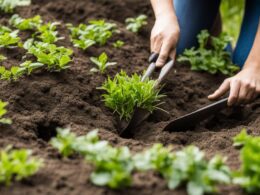If you want to achieve a healthy and vibrant lawn, reseeding in the spring is a crucial step in your lawn care routine. By filling in bare spots and improving turf density, reseeding can revitalize your worn-down lawn and enhance its appearance. It is especially beneficial for lawns with depleted soil, poor water drainage, insufficient fertility, or inadequate sunlight.
To successfully reseed your lawn in the spring, it’s essential to select top-quality grass seed and follow the proper steps. With the right approach, you can enjoy a lush and beautiful lawn that will be the envy of your neighbors.
In this comprehensive guide, we will walk you through the entire process of spring lawn reseeding. From assessing your lawn for winter damage to preparing the soil, choosing the right grass seed, and implementing overseeding and aeration techniques, we’ve got you covered. We will also discuss the importance of maintaining proper soil health, fertilization, and weed control to ensure the long-term success of your reseeded lawn.
Whether you’re a seasoned gardener or a first-time homeowner, this guide will provide you with all the information you need to revitalize your lawn and enjoy a lush and vibrant turf in the spring.
The Importance of Overseeding in Spring
Overseeding is a crucial component of your comprehensive lawn care plan, especially in the spring. It offers numerous benefits, including enhancing the health and appearance of your lawn, increasing grass density, and rejuvenating aging or thin lawns. By introducing new grass varieties through overseeding, you can create a lush and vibrant turf that enhances the natural beauty of your outdoor space.
One of the significant advantages of overseeding is its cost-effectiveness. By repairing bare patches and promoting grass growth, overseeding reduces the need for excessive watering, fertilizing, and pesticide use. Additionally, it helps fill in areas with depleted grass cover, strengthening the overall resilience of your lawn.
Assessing Your Lawn for Winter Damage
Before reseeding your lawn, it is essential to assess any damage caused by winter conditions. Winter can take a toll on your lawn, resulting in various issues that need attention. Two common problems to look out for are snow mold and bare spots.
Snow mold appears as circular white or pink patches on the grass after the snow melts. It is a fungal disease that thrives in cool, moist conditions, typically occurring during wet winters. If left untreated, snow mold can damage the grass and create unsightly patches on your lawn.
Another common issue is bare spots, which can be caused by heavy snowfall, ice accumulation, or excessive foot traffic. These areas lack grass and can make your lawn appear thin and uneven.
Assessing and addressing these winter lawn damages is crucial before proceeding with reseeding. By taking the time to identify these issues early on, you can ensure effective lawn reseeding and achieve a healthy and vibrant lawn.
To accurately diagnose and address winter damage, it may be beneficial to consult with professional lawn care experts. They have the knowledge and expertise to identify the specific problems and provide appropriate treatments.
For snow mold, they may recommend using fungicides to control the disease. Treating bare spots may involve a combination of aeration and overseeding, which helps fill in the gaps and promote new grass growth.
By addressing winter damage before reseeding, you are setting the foundation for a successful lawn reseeding process. This proactive approach will ensure that your lawn is healthy and ready for new growth, resulting in a lush and beautiful landscape.
Preparing Your Lawn for Reseeding
Before reseeding your lawn, it is important to prepare the turf for new growth. This involves several essential steps to ensure optimal conditions for the grass to thrive.
Spring Lawn Cleanup: Start by removing any debris that has accumulated over the winter, such as fallen leaves, branches, and other yard waste. This will promote proper airflow and sunlight penetration, allowing the new grass seed to establish and grow.
Pruning Trees and Shrubs: Take the time to prune any overgrown or damaged trees and shrubs in your yard. This not only stimulates new growth but also helps maintain the overall health and structure of your landscape. Trim any dead or diseased branches to create a clean and well-maintained appearance.
Thatch Buildup: It is essential to address thatch buildup before reseeding your lawn. Thatch is a layer of dead grass and debris that accumulates between the soil and the turf. Excessive thatch can hinder the penetration of water and nutrients, preventing new grass from thriving. Consider dethatching your lawn to remove this layer and create optimal conditions for the new grass seed.
By following these steps and properly preparing your lawn for reseeding, you will create an ideal environment for new grass growth. Remember to take the time to clean up debris, prune trees and shrubs, and address thatch buildup for a successful reseeding process.
The Role of Soil Health in Lawn Reseeding
Soil health plays a crucial role in the successful reseeding of your lawn. Conducting a comprehensive soil test is the first step in understanding your soil’s composition and addressing any potential deficiencies or imbalances. Through soil testing, you can gain valuable insights into pH levels and nutrient content, enabling you to make informed decisions regarding necessary soil amendments.
Once you have the results of your soil test, you can implement appropriate soil amendments to create an optimal growing environment for your grass. By addressing any nutrient deficiencies and adjusting the pH levels, you can provide the necessary foundation for healthy root development and nutrient uptake. This will help ensure that the reseeded grass can thrive and establish a strong root system.
In addition to soil amendments, proper irrigation practices are essential for supporting the growth of newly reseeded grass. Maintaining the right moisture balance is crucial for optimal root development and nutrient absorption. By following appropriate irrigation practices, you can ensure that your reseeded lawn receives adequate water without overwatering, which can lead to shallow root growth and other issues.
By prioritizing soil health through soil testing, amendments, and proper irrigation practices, you can create a solid foundation for a vibrant and healthy lawn. A healthy soil ecosystem supports robust grass growth, increases resistance to disease and pests, and improves overall lawn resilience.
Aeration and Overseeding for Lawn Reseeding
Aeration and overseeding are two essential practices for achieving a healthy and resilient lawn. Aeration helps relieve soil compaction and improve air and water circulation, creating an optimal environment for grass roots to flourish. By creating small holes in the soil, aeration enables essential nutrients and water to penetrate deep into the roots, promoting healthier growth and increasing the lawn’s overall resilience.
Overseeding, on the other hand, involves adding new grass seed to an existing lawn to fill in bare spots and improve turf density. When performing overseeding, choosing the right grass seed is crucial for optimal results. Select a grass seed variety that is compatible with your specific climate and soil conditions. Consider factors such as shade tolerance, drought resistance, and foot traffic tolerance when making your selection.
There are two commonly used techniques for overseeding: mechanical slit-seeding and broadcast seeding. Mechanical slit-seeding involves using a specialized machine to create small grooves in the soil and directly deposit the grass seed. This method ensures better seed-to-soil contact and increases the chances of successful germination.
On the other hand, broadcast seeding involves spreading the grass seed by hand or using a spreader. It is a more straightforward method and suitable for smaller areas. However, it may require some additional steps to ensure proper seed-to-soil contact, such as raking the seed into the soil or using a light topdressing.
Regardless of the method you choose, it is essential to follow proper overseeding techniques. Start by preparing the lawn by mowing it at a shorter height and removing any debris or thatch. Then, spread the grass seed evenly, making sure to overlap slightly to avoid missing any areas. After overseeding, lightly water the lawn to ensure good seed-to-soil contact and provide a moist environment for germination.
Aeration and overseeding work synergistically to promote a healthy and robust lawn. By regularly aerating your lawn and strategically overseeding, you can address bare spots, improve grass density, and create a lush and vibrant lawn. Remember to follow proper lawn care practices, such as appropriate watering and fertilization, to support the growth of the newly seeded grass and maintain a healthy lawn throughout the growing season.
Fertilization and Weed Control for Reseeded Lawns
After reseeding your lawn, it is crucial to prioritize customized fertilization to ensure the healthy growth of new grass. Customized fertilization helps provide the essential nutrients that your reseeded lawn needs during the growing season. Incorporating slow-release fertilizers can be particularly beneficial as they release nutrients gradually, providing a steady supply of nourishment to support optimal grass growth.
In addition to fertilization, effective weed control is essential to maintain the health and appearance of your reseeded lawn. Pre-emergent weed control treatments can be applied to prevent the germination of common weeds such as crabgrass. These treatments create a barrier that inhibits weed growth without harming the newly reseeded grass.
Post-emergent weed control is equally important for managing any emerging weed issues. This involves targeting and eliminating weeds that have already sprouted in the reseeded lawn. Regular monitoring and ongoing lawn care practices, such as mowing and watering, can help control and minimize weed growth.
By combining customized fertilization and effective weed control techniques, you can maintain the health, vibrancy, and density of your reseeded lawn, ultimately achieving the lush, thriving turf you desire.
Can Post-Emergent Weed Control Techniques Help with Spring Reseeding?
Post-emergent weed control techniques can help boost lawn health with weed control by eliminating the competition for water, nutrients, and sunlight. This can create ideal conditions for spring reseeding, allowing new grass seed to establish and thrive without being overshadowed by invasive weeds.
Conclusion
Spring lawn reseeding is a crucial step to rejuvenate your worn-down or thin lawn and achieve a lush, vibrant turf with improved grass density. By following the proper techniques and giving your lawn the care it needs, you can enjoy a revitalized and beautiful landscape in the spring.
Assessing winter damage is the first step in the reseeding process. Addressing issues like snow mold and bare spots early on ensures that your lawn is ready for new growth. Then, take the time to prepare your lawn by removing debris, pruning trees and shrubs, and addressing thatch buildup. These steps create the ideal conditions for new grass seed to thrive.
Prioritizing soil health is essential for successful lawn reseeding. Conduct a soil test to identify any deficiencies and make necessary amendments. By maintaining the right moisture balance through proper irrigation practices, you’ll provide the best environment for healthy root development and nutrient uptake.
Aeration and overseeding are powerful techniques that enhance your lawn’s health and resilience. Aeration relieves soil compaction, while overseeding fills in bare spots and improves turf density. Choose the appropriate grass seed and seeding method that suits your lawn’s conditions and desired results.
To maintain the long-term health and appearance of your reseeded lawn, proper fertilization and weed control are crucial. Customized fertilization ensures your new grass has the essential nutrients it needs, while pre-emergent and post-emergent weed control treatments prevent weed infestations. Don’t forget to continue with ongoing lawn care practices to keep your lawn looking its best.
In conclusion, with the right approach, including assessing winter damage, preparing your lawn, prioritizing soil health, utilizing aeration and overseeding techniques, and implementing proper fertilization and weed control, you can achieve a revitalized and beautiful lawn in the spring. Enjoy the satisfaction of a vibrant and healthy turf throughout the season.











